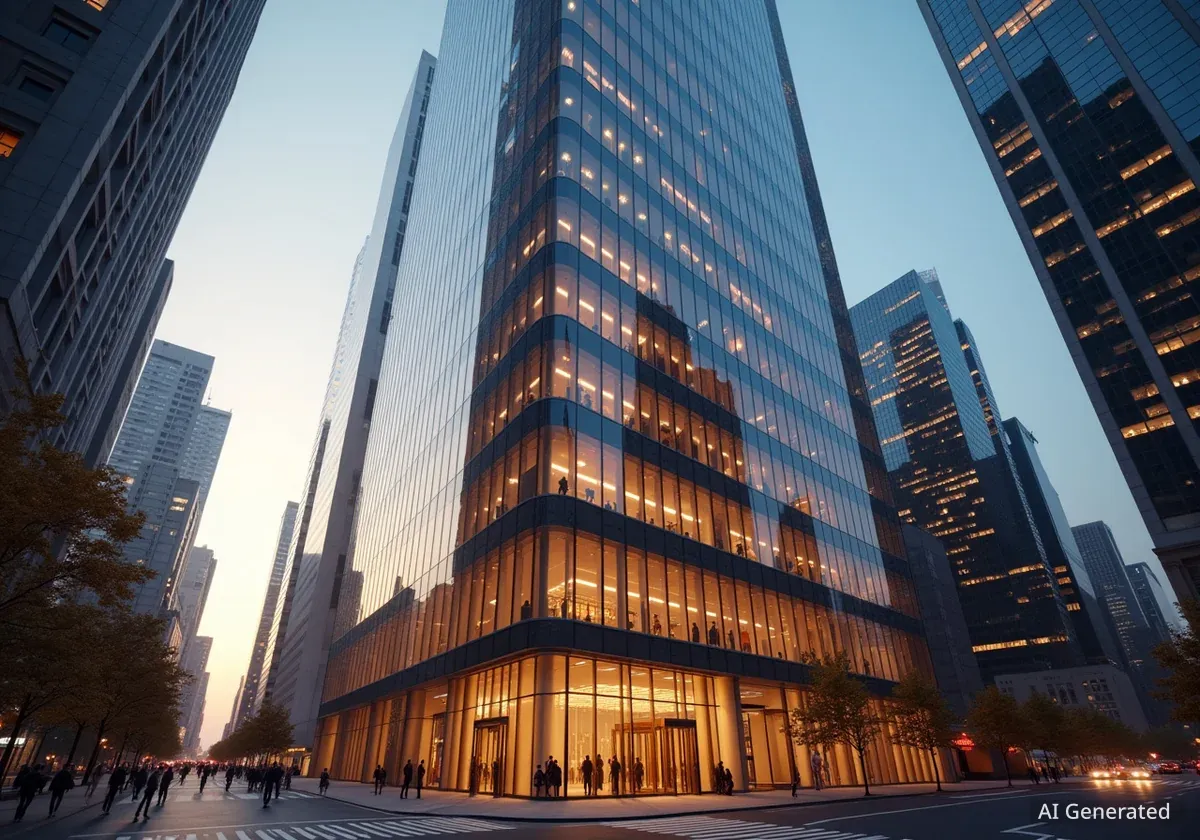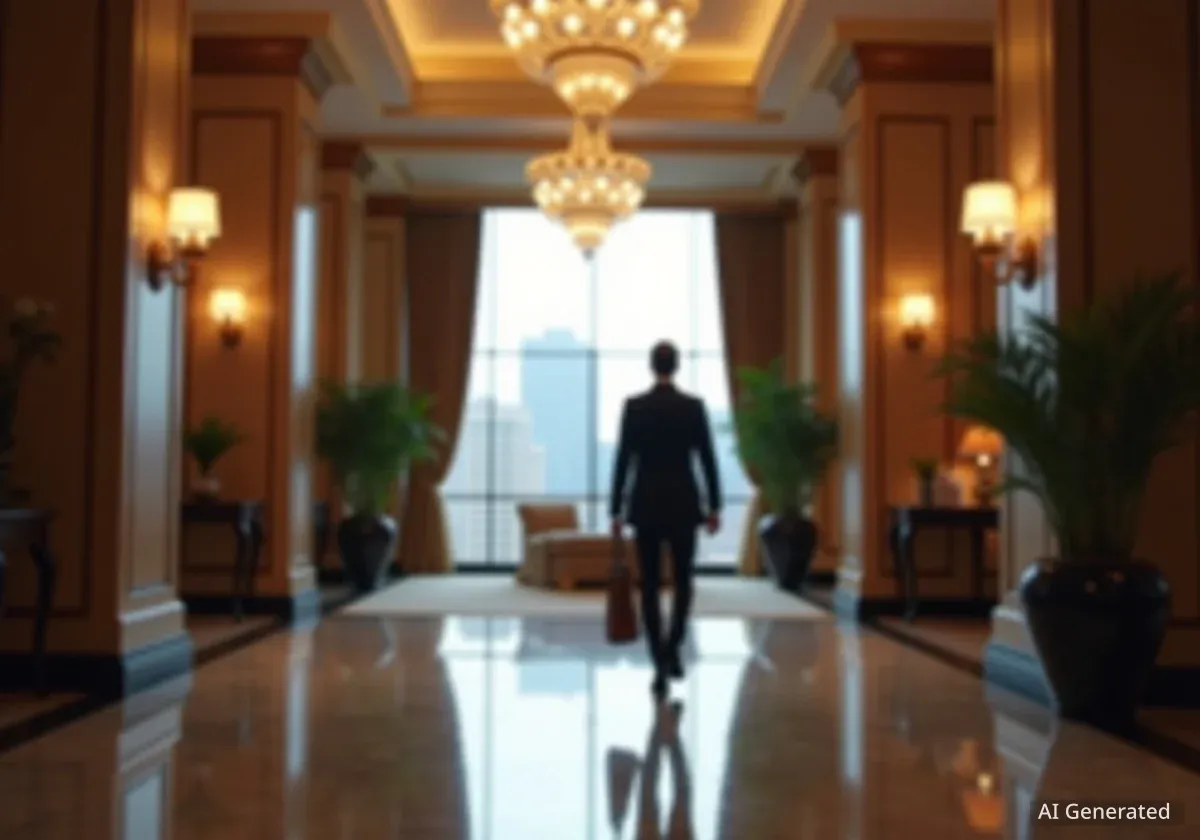JP Morgan Chase has officially unveiled its new headquarters at 270 Park Avenue in New York City. The towering structure, designed by Foster + Partners, stands as a significant addition to the Manhattan skyline, aiming to redefine the modern corporate workspace.
This 1,388-foot skyscraper is more than just an office building. It features an extensive range of amenities designed to cater to nearly every employee need throughout the workday and into the evening. The project represents a growing trend among corporations to create self-contained environments for their workforce.
Key Takeaways
- JP Morgan Chase's new headquarters at 270 Park Avenue is 1,388 feet tall.
- The building includes a 19-restaurant food hall, gym, medical office, and outdoor terraces.
- It aims to create a 'city within a city' experience for employees.
- The project reflects a corporate strategy to encourage in-person work.
- Its construction involved the demolition of the 1960 Union Carbide building.
A Monument to Modern Finance and Work Culture
The new JP Morgan Chase tower is a striking presence in Midtown Manhattan. Its design incorporates steel struts and large abstract art pieces, creating a grand, cathedral-like lobby. The building's sheer scale is impressive, with a floor area of 2.5 million square feet.
This immense size was made possible through a special zoning rights agreement. The agreement involved properties near Grand Central Station and St. Bartholomew’s Church. This allowed for a much larger structure than typically permitted on a single city block.
Building Facts
- Height: 1,388 feet
- Floor Area: 2.5 million square feet
- Restaurants: 19-restaurant food hall
- Amenities: Gym, medical office, yoga/meditation spaces, mothers' rooms, outdoor terraces
- Lighting: Circadian lighting system
Before its construction, the site housed the 1960 Union Carbide building. This structure was the tallest building in America ever to be voluntarily demolished. Its removal faced protests from conservationists and environmental groups.
Creating a 'City Within a City'
The concept behind 270 Park Avenue is to provide employees with an environment where they rarely need to leave. Foster + Partners, the British architectural firm behind the design, describes it as a 'city within a city'.
Inside, employees have access to a wide array of services and amenities. These include a diverse 19-restaurant food hall, various cafes, and even a pub. Health and wellness facilities are also prominent, with a gym, medical office, yoga and meditation spaces, and specialized mothers' rooms.
Beyond the practical, the building emphasizes employee comfort and well-being. High ceilings create a sense of spaciousness, and circadian lighting systems adapt to natural light cycles. Outdoor terraces offer green spaces for relaxation and fresh air.
"We are building a workplace that supports our employees' well-being and productivity," stated a company representative. "This building is designed to foster collaboration and innovation."
Historical Roots of Corporate Utopias
The idea of a comprehensive corporate community is not new. It dates back to the 19th century with projects like Saltaire in England. Textile manufacturer Sir Titus Salt built Saltaire between 1851 and 1871 for his workers. This model village offered housing, concert halls, libraries, gyms, and parks.
Historical Precedents
Early corporate communities like Saltaire, Port Sunlight, and Bournville aimed to provide superior living and working conditions. These villages often included amenities like libraries, concert halls, and parks, but also imposed strict behavioral codes, often prohibiting pubs.
Similar visions shaped Port Sunlight on Merseyside, developed by the Lever family for soap factory workers. The Cadbury family also created Bournville outside Birmingham. These communities aimed to create environments where 'healthy, right-living, and well-paid workers lived in safe, happy homes'.
While these historical examples offered better conditions than urban slums, they often came with strict rules. Employees were expected to conform to the founders' moral standards. For instance, many of these villages had no pubs.
Modern Iterations and the Push for In-Person Work
In recent decades, modern technology companies have revived this concept. Apple Park in Cupertino, also designed by Foster + Partners, is another example of a corporate campus designed to be an immersive world. It features idyllic landscapes and lavish facilities.
JP Morgan Chase's new headquarters adapts this idea for a dense urban setting. The bank's chairman and chief executive, Jamie Dimon, has been a vocal proponent of in-person work. He believes it is essential for mentoring, learning, brainstorming, and overall productivity.
270 Park Avenue serves as a powerful tool to encourage employees to return to the office. It offers an environment so rich in amenities that leaving during the workday becomes less appealing. This strategy is part of a broader trend, especially since the Covid-19 pandemic, to revitalize office spaces through 'wellness' initiatives.
Other examples include 22 Bishopsgate in the City of London. This building features a climbing wall, a retreat space, and multiple food and drink options. Developers often refer to these modern corporate hubs as 'villages' or 'cities'.
However, critics note that these curated environments lack the spontaneity of real urban spaces. Despite being next to Grand Central, offering easy access to suburban homes, the sheer completeness of the tower's offerings raises questions about the perceived benefit of being in the heart of Manhattan if one rarely interacts with the city outside.




